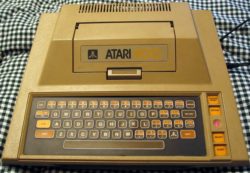I’m not a tech-savvy person. I like to sit down at my computer and write without having to figure out a bunch of new features and updates. When I can’t find what I need quickly, I get crabby. That’s when I take a deep breath and look up at my office bookshelves where I have two items that help me keep things in perspective. The first is this antique typewriter:
I began writing my first novel on a manual typewriter—not as old as this one, but a portable one that I had in college. If I made a typo or I wanted to change something, I brushed White-Out over the error, waited for it to dry, then typed over the newly-painted spot. If I wanted to edit or improve something it meant re-typing the entire chapter. Then I discovered Correct-Type strips that could make errors disappear. These were okay to use for a spot or two, but too many corrections made the page look messy. Then came erasable typing paper—but that was too expensive to use for an entire novel and the ink tended to smear if I wasn’t careful.
After working on my first novel for about a year, my husband surprised me with an electric typewriter with auto-correct. If I typed backwards over the mistake, the correction tape would erase it. Genius! Plus, I could write faster since I no longer had to pound on a manual keyboard.
 My husband has always believed in me (even when I doubted myself), so we were among the first households to switch to a computer—a clunky Atari with 3 ½ inch discs. Typos and errors were easy to fix and I could print out flawless copies on my dot-matrix printer. Now my mistakes and frustrations became technological ones as I struggled to learn how to use these new machines. But my writing improved exponentially because it was easy to make edits and improvements. I now own a laptop computer as well as a desktop, which gives me the freedom to write anywhere.
My husband has always believed in me (even when I doubted myself), so we were among the first households to switch to a computer—a clunky Atari with 3 ½ inch discs. Typos and errors were easy to fix and I could print out flawless copies on my dot-matrix printer. Now my mistakes and frustrations became technological ones as I struggled to learn how to use these new machines. But my writing improved exponentially because it was easy to make edits and improvements. I now own a laptop computer as well as a desktop, which gives me the freedom to write anywhere.
In spite of these updates, I still get frustrated. That’s when I glance up at the antique typewriter on my shelf and say to myself, “It could always be worse.” If that doesn’t work, I look up at another shelf and see this:
Yes, it’s an old-fashioned quill pen and inkwell. I try to imagine William Shakespeare’s frustration as he wrestled with drippy ink and fussy quills. Or the patience required by the Bible’s authors who scratched out their books on parchment scrolls. Compared to them, I guess I have it pretty good.
 I’m often tempted to look back with nostalgia at the “good old days,” especially when I see changes in the world that frighten me. It’s easy to forget that in those “good old days” my family owned only one car (which my dad drove to work, forcing us to walk everywhere); we had no dishwasher (which meant we had to wash all the dishes, 365 days a year); our clothes dryer was the sun and a clothesline in the backyard; and our telephone was attached to the kitchen wall. I long to return to those “good old days” about as much as I long to write my next book on my antique typewriter!
I’m often tempted to look back with nostalgia at the “good old days,” especially when I see changes in the world that frighten me. It’s easy to forget that in those “good old days” my family owned only one car (which my dad drove to work, forcing us to walk everywhere); we had no dishwasher (which meant we had to wash all the dishes, 365 days a year); our clothes dryer was the sun and a clothesline in the backyard; and our telephone was attached to the kitchen wall. I long to return to those “good old days” about as much as I long to write my next book on my antique typewriter!
 I’m learning that change isn’t always bad. In fact, God built it into the universe. That’s obvious from looking at the trees outside my office window. So the question is, am I allowing God to use the changes in my life—the bad ones as well as the good ones—to transform me into the person He wants me to be? Am I changing for the better, or becoming a grouch who hates change? As summer ends and I see the harvest all around me, I should to be bearing fruit, too—spiritual fruit like love, joy, peace, patience, kindness, goodness, faithfulness, gentleness and self-control (Galatians 5:22). I need God to update me into a new-improved version. Because if I don’t, I have a feeling my life will be as frustrating as writing a novel with a quill pen.
I’m learning that change isn’t always bad. In fact, God built it into the universe. That’s obvious from looking at the trees outside my office window. So the question is, am I allowing God to use the changes in my life—the bad ones as well as the good ones—to transform me into the person He wants me to be? Am I changing for the better, or becoming a grouch who hates change? As summer ends and I see the harvest all around me, I should to be bearing fruit, too—spiritual fruit like love, joy, peace, patience, kindness, goodness, faithfulness, gentleness and self-control (Galatians 5:22). I need God to update me into a new-improved version. Because if I don’t, I have a feeling my life will be as frustrating as writing a novel with a quill pen.


1 comments
Obrigadaaaa! Adorei o post! Adoro me jogar em compras mesmo sem poder! E como o ebay as vezes é tiro no escuro, é muito bom ter outras exinªpÃrecias… Já conhecia alguns vendedores e já vou garantir o que gostei! Bjo
Comments are closed.